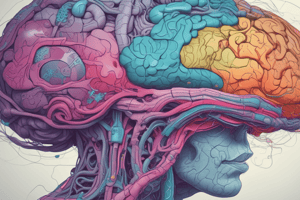Podcast
Questions and Answers
What is the primary cause of Parkinson's disease?
What is the primary cause of Parkinson's disease?
- degeneration of serotonin-producing cells in the brainstem
- degeneration of dopamine-producing cells in the basal ganglia (correct)
- loss of acetylcholine receptors in the hippocampus
- increased production of glutamate in the cortex
Which of the following is a role of the basal ganglia in motor control?
Which of the following is a role of the basal ganglia in motor control?
- controls muscle tone in trunk and postural control muscles
- modulating spinal reflexes to prevent hyperactivity
- refining proprioceptive feedback for balance and posture
- regulation of movement timing and inhibition of unwanted movements (correct)
Which component of the basal ganglia produces dopamine?
Which component of the basal ganglia produces dopamine?
- substantia nigra (correct)
- caudate nucleus
- globus pallidus
- subthalamic nucleus
Which of the following is a risk factor for Parkinson's disease?
Which of the following is a risk factor for Parkinson's disease?
What is the mainstay intervention for the treatment of symptoms related to Parkinson's disease?
What is the mainstay intervention for the treatment of symptoms related to Parkinson's disease?
What is a common effect of long-term levodopa treatment?
What is a common effect of long-term levodopa treatment?
What stretching modality is most commonly recommended for improving flexibility in Parkinson's disease patients?
What stretching modality is most commonly recommended for improving flexibility in Parkinson's disease patients?
What is the basal ganglia role
What is the basal ganglia role
Match
Match
Basal Ganglia contributes to executive function, behavior, and emotion
Basal Ganglia contributes to executive function, behavior, and emotion
BG influences movement through direct and indirect pathways. Direct pathways inhibit the thalamus and PPN in brainstem to facilitate movement. Indirect pathways excites thalamus and PPN in brainstem to inhibit unwanted movement
BG influences movement through direct and indirect pathways. Direct pathways inhibit the thalamus and PPN in brainstem to facilitate movement. Indirect pathways excites thalamus and PPN in brainstem to inhibit unwanted movement
Name the 4 cardinal motor symptoms
Name the 4 cardinal motor symptoms
Name the 4 non cardinal PD motor symptoms
Name the 4 non cardinal PD motor symptoms
What are on 'on-off' fluctuations?
What are on 'on-off' fluctuations?
What can cause on-off fluctuations of levodopa?
What can cause on-off fluctuations of levodopa?
Name the 4 absolute red flags for exercise
Name the 4 absolute red flags for exercise
Flashcards are hidden until you start studying



